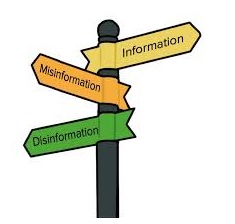By Mohamed Abdi
Misinformation and disinformation deceive people and divert their direction and decision making aptitudes. But what are they? Misinformation is to unintentionally mislead people, while disinformation is to intentionally mislead them. In other words, misinformation is to share fake news without the intention of hurting anyone, but disinformation is to create false information and spread it with the intention of harming someone else. Hence, propaganda and rumours are part of disinformation, as they are intended to hurt people in one way or another. “Disinformation is duping, Misinformation is tricking,” said Toba Beta, an Indonesian writer.

Although it is a journalist’s duty to gather data and report truth, there are some unethical people engaged in news production who continuously misinform and disinform the public by disseminating bogus news. Those individuals create and propagate false news and information, and enjoy misleading and damaging the public. Therefore, it is imperative to be cautious of their deceiving techniques, or else one would fall in their traps and languish there forever.
Disinformation can come in the form of false quotations, manipulated pictures, or distorted sounds. For example, someone can write a news story and insert false quotesin it, claiming they are from, say, doctor so and so, or politician so and so. Now this news story is disinforming the public, for it is neither credibly sourced nor genuinely written. In fact, by making up false quotations, the intention of the news story’s writer is to liken his or her message to something true, though it is far from truth. That can be one instance when it comes to print media.
The same thing applies to broadcast media. Both words and pictures can be distorted to disinform the general public and skew their viewpoints. For example, some skilled individuals can select certain photos and put them in carefully designed settings to convey a particular message. They can, for example, photoshop pictures and make them look like what they are not, or do not act. It is also disinformation to take old photos and set them in new contexts, aiming to establish specific suppositions. Like pictures, sounds can be corrupted to conform to wanted situations, such as to make someone’s voice sound a drunken voice, an angry voice, or a swearing one, just to mention a few examples.
How to recognize misinformation and disinformation? In fact, the secret to understanding disinformation and its magnitude effects lies in someone’s intuition and analytical ability, but there are signs that hint at the presence of the disinformation ploys, despite their obscurity often times. They right away trigger an emotional reaction and immediate thinking, causing one to ask a multitude of questions: Is this true? Why it is being so? Who is doing it? After all, the sole intention of false contents creators is to trigger an emotional response so as to achieve a particular objective. Therefore, it is necessary for one to pause and ponder to check and ask the validity of read, viewed, or heard contents before imparting them. Indeed, it behooves the public to ask these below stated questions: Is this an accurate news story, an article, an original picture, or a genuine sound? Who is posting/sharing this information? Who wrote or created this information? When was it created and for whom? It is also beneficial to seek advice from trusted sources.
Both individual people and news outlets have an intrinsic bias or political tendency, but some are more credible and reliable than others. So it is recommended to get news and information from conventional sources and credible people, or else one would run the risk of subsisting on bogus news and information.
Doubtlessly, though, social media has become a conventional source of news and information for a large segment of the world’s population; and nowadays fake news spreads like wildfire on the social media channels (Facebook, You Tube, Twitter, WhatsApp, Instagram, TikTok), making one unable to fathom which news is true, and which one is not. Moreover, sharing false information increases its visibility, so when people publicize phony news they help amplify it and delude the general public. Some social media channels have realized the significance of fighting scandalous information. Facebook promised that it will fight fake news. “We take misinformation seriously,” wrote the company’s CEO Mark Zuckerberg.
Misinformation and disinformation, of course, confuse every aspect of people’s lives, and put them in volatile conditions, deterring them from making informed choices, or reaching wise decisions.“Viral diseases are not as contagious as rumours go viral on media”, says Srinivas Mishra, an Entrepreneur and a blogger. All in all, people ought to wake up to the devastating effects of misinformation and disinformation, and be cautious of consumed news and information.
Mohamed Abdi is a Somali-Canadian Writer
Email: [email protected]
We welcome the submission of all articles for possible publication on WardheerNews.com. WardheerNews will only consider articles sent exclusively. Please email your article today . Opinions expressed in this article are those of the author and do not necessarily reflect the views of WardheerNews.
WardheerNew’s tolerance platform is engaging with diversity of opinion, political ideology and self-expression. Tolerance is a necessary ingredient for creativity and civility.Tolerance fuels tenacity and audacity.
WardheerNews waxay tixgelin gaara siinaysaa maqaaladaha sida gaarka ah loogu soo diro ee aan lagu daabicin goobo kale. Maqaalkani wuxuu ka turjumayaa aragtida Qoraaga loomana fasiran karo tan WardheerNews.
Copyright © 2024 WardheerNews, All rights reserved


